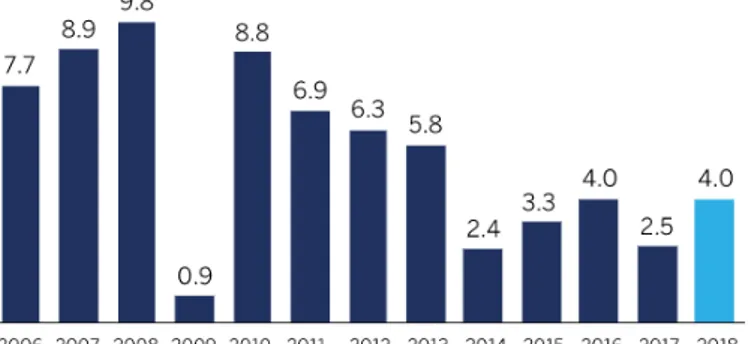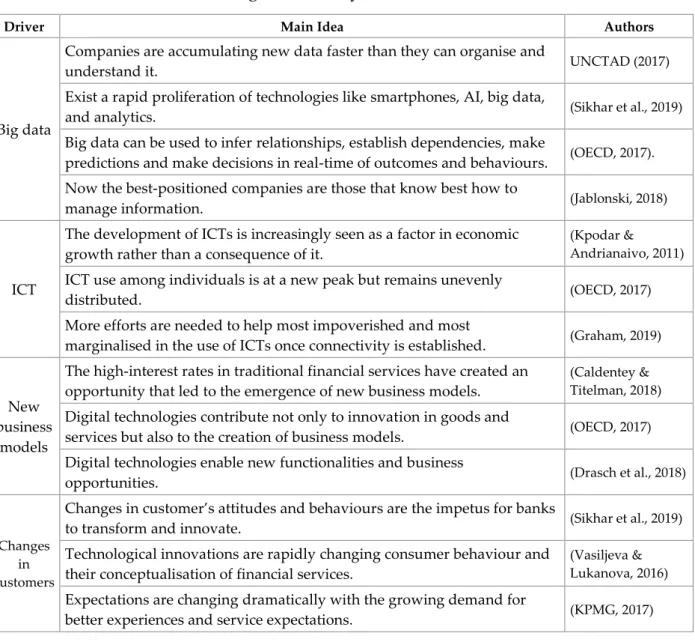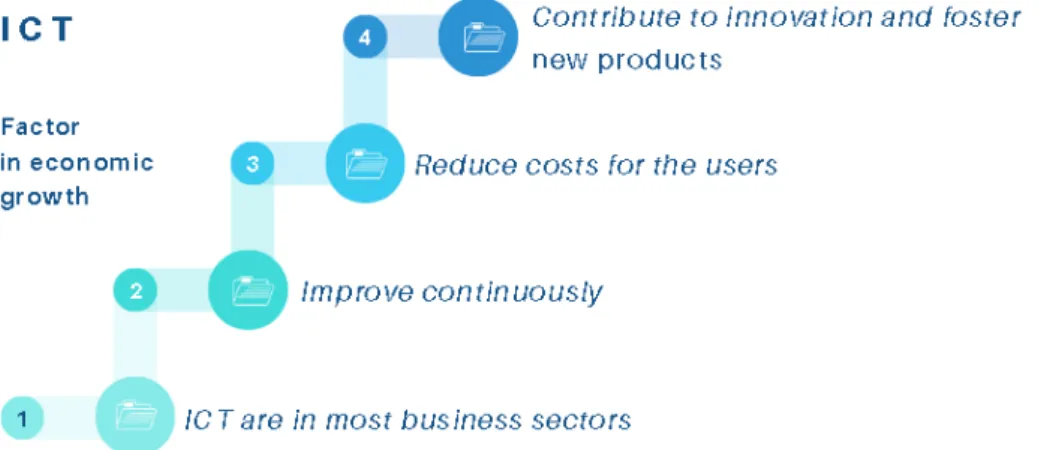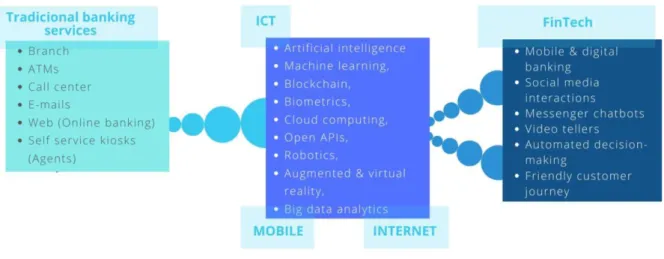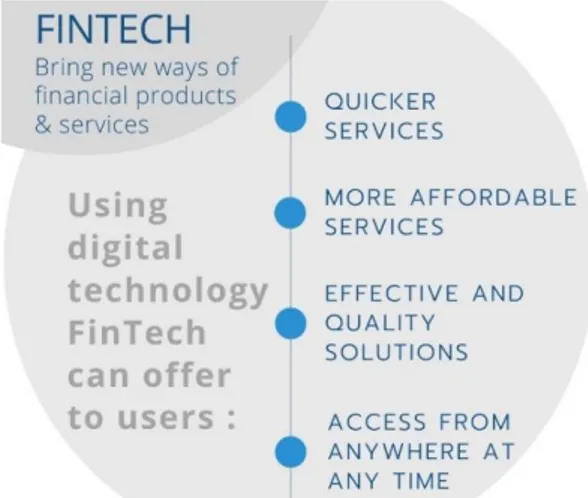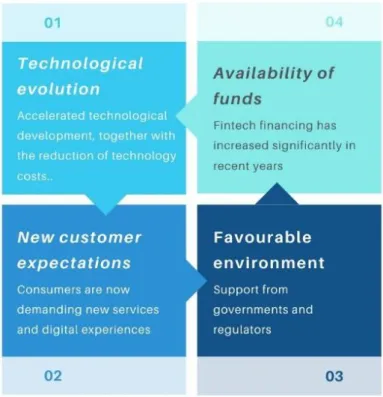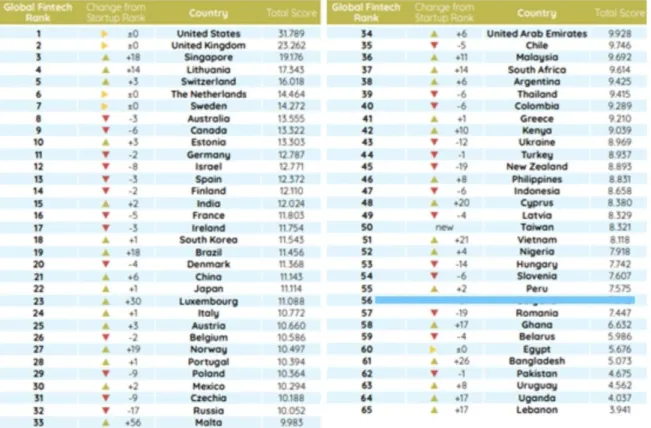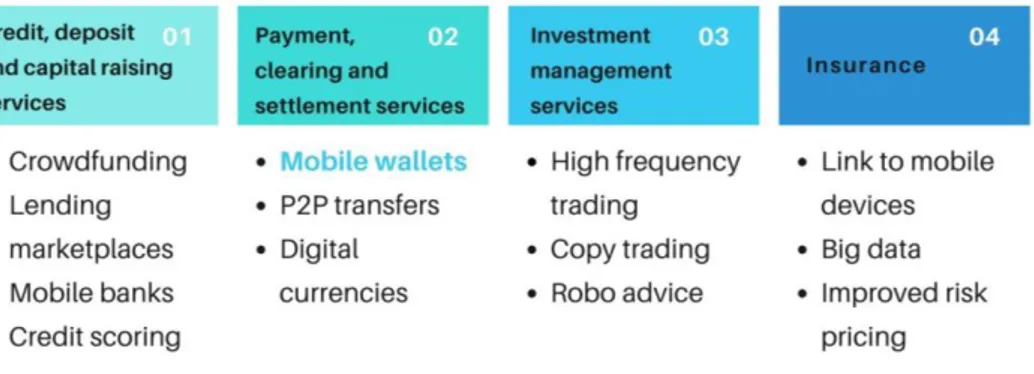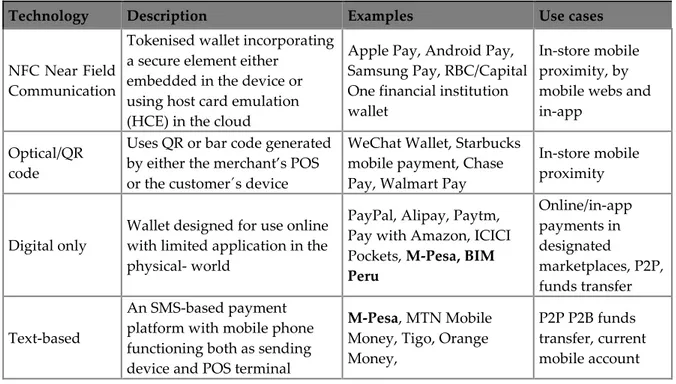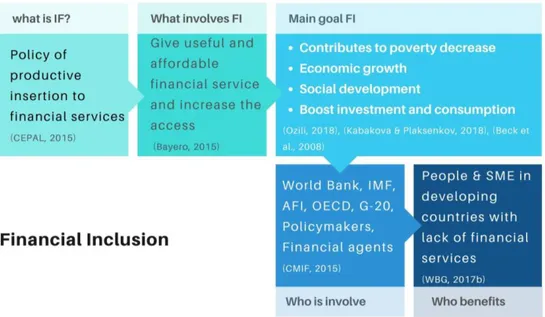Digital transformation in the banking
sector and its impact on financial
inclusion
BIM Peru Case Study
By
Tonny Inga Ayllon
Católica Porto Business School, Universidade Católica Portuguesa 2020
i
Digital transformation in the banking
sector and its impact on financial
inclusion
BIM Peru Case Study
Final work presented to the Universidade Católica Portuguesa in the modality of a dissertation to obtain the degree of Master in Marketing
By
Tonny Inga Ayllon
Under the orientation of
Prof. PhD. Jorge Julião Prof. PhD. Marcelo Gaspar
Católica Porto Business School, Universidade Católica Portuguesa 2020
iii
Abstract
Purpose. The objective is to understand how the digital transformation in the
banking sector can foster financial inclusion. Besides, the study addresses the main concepts of the digital economy, digital transformation, FinTech, and we will focus on financial inclusion and their issues. Besides, it is interesting to understand through real business cases how advances in technology can also benefit disadvantaged target groups. This study will concentrate on Peru because it is considered one of the leading emerging markets in South America. However, it has one of the lowest rates of financial inclusion in the region. Therefore, we will analyse the specific case of BIM mobile wallet, which aims to reach the unbanked people.
Method. The method used was the qualitative analysis of content with the intention
of understanding and identified the main drivers of the digital transformation, its opportunities and impact on financial inclusion. Moreover, the case study methodology was chosen to develop insights and to make a depth description of BIM. In addition, a questionary and interview were also designed to complement the study.
Findings. The technological revolution in the financial sector has led to the
emergence of FinTech, whose products can be used to reach and serve the un-banked and thus promote financial inclusion.
Research limitations. There is still not enough academic information about the use
of new technologies to promote financial inclusion in Latin America, because the topic is still new in the region, especially in Peru.
Originality/value. This study contributes to the academic literature, first, by
offering an overview of the available knowledge about digital transformation in the financial sector and financial inclusion; secondly, by analysing the situation of financial inclusion in Peru and the specific case of BIM.
Keywords. Digital economy, Digital transformation, Mobile wallet, Financial
iv
Abstrato
Objetivo. O objetivo é entender como a transformação digital no setor bancário
pode promover a inclusão financeira. Além disso, o estudo aborda os principais conceitos de economia digital, transformação digital, FinTech, e focaremos na inclusão financeira e seus problemas. Além disso, é interessante entender através de casos reais de negócios como os avanços na tecnologia também podem beneficiar grupos-alvo desfavorecidos. Este estudo se concentrará no Peru, pois é considerado um dos principais mercados emergentes da América do Sul. No entanto, possui uma das taxas mais baixas de inclusão financeira na região. Portanto, analisaremos o caso específico da carteira móvel BIM, que visa atingir as pessoas não-bancárias.
Método. O método utilizado foi a análise qualitativa do conteúdo, com o intuito de
compreender e identificar os principais direcionadores da transformação digital, suas oportunidades e impacto na inclusão financeira. Além disso, a metodologia do estudo de caso foi escolhida para desenvolver insights e fazer uma descrição detalhada do BIM. Além disso, também foram elaborados um questionário e uma entrevista para complementar o estudo.
Constatações. A revolução tecnológica no setor financeiro levou ao surgimento da
FinTech, cujos produtos podem ser usados para alcançar e servir os não bancários e, assim, promover a inclusão financeira.
Limitações de pesquisa. Ainda não há informações acadêmicas suficientes sobre o
uso de novas tecnologias para promover a inclusão financeira na América Latina, porque o tema ainda é novo na região, especialmente no Peru.
Originalidade / valor. Este estudo contribui para a literatura acadêmica,
primeiramente, oferecendo uma visão geral do conhecimento disponível sobre transformação digital no setor financeiro e inclusão financeira; segundo, analisando a situação da inclusão financeira no Peru e o caso específico do BIM.
Palavras-chave. Economia digital, Transformação digital, Carteira móvel, Inclusão
v
Index
Abstract ... iii
Acknowledgements... vii
Index ... viii
Figure index ... viii
Table index ... ix
Acronym index ... x
Chapter 1- Introduction ... 1
1.1 Background and motivations ... 1
1.2 Theme and research question ... 2
1.3 Scope and general research gap ... 4
1.4 Methodology ... 4
1.5 Document structure ... 5
Chapter 2- Literature Review ... 6
2.1 Path to a digital environment ... 6
2.2 Digital Economy ... 7
2.3 Key Drivers for Digital Economy ... 8
2.3.1 Big data ... 10
2.3.2 ICT ... 10
2.3.3 New business models ... 11
2.3.4 Changes in consumers ... 12
2.4 Digital Transformation in the Financial Sector ... 13
2.5 FinTech ... 14
2.5.1 FinTech Classification ... 17
2.5.2 E-Money and Mobile-Wallet. ... 18
2.6 Financial Inclusion FI ... 20
2.6.1 The benefits of FI ... 23
2.6.2 World current situation ... 24
2.6.3 Latin America landscape ... 26
2.6.4 Opportunity ... 28
2.6.5 The challenge ... 29
2.6.6 Best practices ... 30
vi
Chapter 3- Methodology and Data Collection ... 36
3.1 Methodology ... 36
3.1.1 Research Methodology ... 36
3.1.2 Methodology Justification ... 37
3.2 Data Collection ... 38
3.2.1 The literature review and case study ... 38
3.2.2 The questionary ... 39
3.2.3 The interview ... 41
3.3 Data Analysis ... 42
Chapter 4- Results Presentation and Analysis ... 43
4.1 Bim Peru Case Study ... 43
4.1.1 Peruvian financial system ... 43
4.1.2 The company, the service and the challenge ... 46
4.1.3 Competitive Analysis ... 48
4.1.4 The Interview ... 50
4.2 Questionary Results ... 52
Chapter 5- Discussion and Conclusions ... 57
5.1 Findings ... 57
5.2 Discussion ... 58
5.3 Limitations and future research ... 60
5.4 Conclusions ... 61
Bibliography ... 1
vii
Acknowledgements
First and foremost, I want to recognise my family, because they always play the role as unconditional support in all my projects and crazy things that I use to assume, like the one that is about to end now, to return after 15 years to the university and to realise this master's degree in a different country and language, which has been a real challenge and a new journey. Also, I want to make a special thanks to my mother, who as always accompanied me in my adventures and even this time she has participated in this because she helped me to get the most questionaries for my research.
I also want to thank my supervisors, the professor Jorge Julião and the professor Marcelo Gaspar, for all the valuable suggestions, knowledge and experience that they shared with me in our meetings and the patience that they have had throughout these last months and most importantly for understanding the context of my situation, to them thank you.
Finally, I would like to thank my group of close friends who, despite the distance, were always aware, keeping me virtual company and supporting me even in moments when everything seems to work against you.
viii
Index
Figure index
Figure 01- Real GDP Year-on-year change (%) Figure 02- Key years in the digital revolution. Figure 03- Characteristics of ICT.
Figure 04- Transition from traditional banking to FinTech. Figure 05- The graphic concept of FinTech.
Figure 06- The drivers of FinTech. Figure 07- FinTech Country Rankings. Figure 08- FinTech services by sector. Figure 09- Overview FI.
Figure 10- Characteristics of financial inclusion. Figure 11- Issues in the supply and demand side. Figure 12- Advantages of mobile money service. Figure 13- Accounts evolution.
Figure 14- Number of Unbanked Adults in Millions. Figure 15- Adults with a bank account in Latin America. Figure 16- Figure Financial inclusion and livelihoods. Figure 17- key requirement for Mobile Financial Service. Figure 18- DFS service evolution as markets mature. Figure 19- M-Pesa strategies.
Figure 20- Evolution of financial inclusion (2015 – 2019).
ix
Figure 22- Total investments and credits. Figure 23- Implementation models of FI.
Figure 24- Global Financial Literacy Questionary Results. Figure 25- Bank account ownership by gender.
Figure 26- Information available about the mobile wallet. Figure 27- Time-saving using a mobile wallet.
Figure 28- Features of the mobile wallet´s users. Figure 29- Mobile wallets vs cash and banks. Figure 30- Why they use or would use the service.
Table index
Table 01- Main features of Peru.
Table 02- Main drivers for the digital economy. Table 03- Effects of ICT.
Table 04- E-Wallet by Delivery Technology. Table 05- Benefits of Financial Inclusion.
Table 06- ATMs and Bank branches per group of countries. Table 07- Main indicators Based on Global Findex.
Table 08- Evolution of Public Policies in FI. Table 09- The four clusters of components. Table 10- KPIs of Financial Services 2019. Table 11- Bank´s Account Fees in $ (SBS). Table 12- Remittance fee.
x
Acronym index
ASBANC Asociación de Bancos del Peru
BCRP Banco Central de Reserva del Peru
BN Banco de la Nacion
DNI Documento nacional de identidad peruano
ENIF Commission for Financial Inclusion
FI Financial Inclusion
ICT Information and communication technologies
IMF International Monetary Fund
NFC Near-field communication
PDP Pagos Digitales Peruanos S.A.
SME Small to mid-size enterprise
Chapter 1- Introduction
1.1 Background and motivations
First and foremost, the appearance of the Internet, its contents, and its digital services have been the most disruptive process in the last two decades. Furthermore, digital technologies contribute not only to innovation in goods and services but also to innovation in processes, new business models and organisational arrangements (OECD, 2017).
Currently, one of the sectors that has been more impacted by these digital technological advances is the banking sector. A sector that for many years remained untouchable and traditional but nowadays is evolving too quickly. New technology appears to be about to "revolutionise" the world of finance not only as a matter of transactional efficiency but also as a matter of social improvement (WBG, 2017b). For instance, one paradigm that can change in the medium term is the demonetisation of payments facilitated by new technologies, which could turn payments into commodities (Shahid & Razaq, 2017).
As a result of this financial revolution, we have the FinTech, which seems to promise a "win-win" solution at the micro level to the many issues of the traditional financial system (Ernst & Young, 2019). Furthermore, FinTech is offering new opportunities also for FI and greater access to financial services. Indeed, FI is a crucial subject for emerging economies, which are cash-dominated, with high informality, money laundering issues and with barriers against e-commerce (Shahid & Razaq, 2017). In harmony with Gupta (2018), said that efforts are being made to encourage the use of digital technologies and make the devices more accessible to all people who are not yet aware of the advantages of this technological revolution.
2
1.2 Theme and research question
This study has been chosen for its importance to understanding how the digital revolution in the banking sector can contribute to promoting FI. Besides, it is interesting to understand through real business case how advances in technology can also benefit disadvantaged and until recently neglected target groups. Finally, with this study, we will analyse accurately the Peruvian market, which astonishingly has a high rate of the unbanked population.
Alongside this challenge, we place the corresponding literature review, addressing the following question- “How can the digital transformation in the banking sector foster Financial Inclusion? The case of BIM Peru”. To answer this research question, it will be essential to understand first how this technological and digital revolution can help those less privileged people, with low access and scarcer resources. This group of people that only some years ago continued excluded or forgotten; however, with the arrival of the FinTech solutions and new services, this current picture is changing for good. Secondly, we must understand what the digital economy is. Then what is a digital transformation in the financial sector and finally what role is playing FinTech and analyse in specific the mobile-wallet as a possible instrument of FI.
This paper will illustrate all these concepts and their application by studying one specific business case, called BIM Peru. As we know, the mobile wallet is a worldwide trend and is the perfect example of digital transformation. For that reason, we will study BIM Peru and its deployment in the Peruvian market as a strategy to promote FI in this country.
Why Peru1? Because nowadays, this country is considered one of the leading emerging markets in South America. Moreover, Peru has an essential and recent
3
history of economic stability based on an uninterrupted annual average growth of 4.5% of its GDP during the last 16 years (Antón & Conde, 2017).
Figure 01- Real GDP Year-on-year change (%) (BCRP)2
Besides, the country stands out for its people with exceptional abilities and high academic standards. Also, it has a crucial natural, cultural and historical resources. However, despite all this, Peru has one of the lowest rates of FI in the region. Therefore, this study will try to understand what is happening and what opportunities Peru has to improve it with the digital financial revolution.
Table 01- Main features of Peru.3
Government
Chief of
State President Martin Alberto VIZCARRA Cornejo Government Presidential republic
Geography
Area Total- 1,285,216 sq km (Portugal + Spain) Natural
Resources
Such as copper, silver, gold, petroleum, timber, fish, iron ore, coal, phosphate, potash, hydropower, natural gas
Economy
GDP $424.4 billion (2017 est.) GDP growth 4% (2018 est.)
Agriculture products
Artichokes, asparagus, avocados, blueberries, coffee, cocoa, cotton, sugarcane, rice, potatoes, corn, plantains, grapes, oranges, pineapples, bananas, apples, lemons, pears, tomatoes, mangoes.
Industries Mining, steel, metal fabrication; petroleum extraction and refining, natural gas and natural gas liquefaction; fishing and fish processing.
People & society
Population Thirty-one million (July 2017 est.). 0.95% (Population Growth)
Language
Spanish (official) 84.1%, Quechua (official) 13%, Aymara (official) 1.7%, Ashaninka 0.3%, Amazonian and other native languages 0.7%, other 0.2% (2007 est.)
Urbanisation Urban population- 77.9% (2018). Annual Rate of urbanisation- 1.44% (2015-20 est.)
2 https://estadisticas.bcrp.gob.pe/estadisticas/series/mensuales/resultados/PN01770AM/html 3 https://www.cia.gov/library/publications/resources/the-world-factbook/geos/pe.html
4
1.3 Scope and general research gap
The study is aimed at analysing the macro concepts involved in the research question. For this purpose, scientific bibliography in the subject from different resources has been consulted. Nevertheless, for the specific case of the digital transformation through the e-wallets, the scope has been limited to Peru. The country where the BIM is being launched, and we will focus on one product, the mobile-wallet BIM.
Indeed, the digital transformation in the financial sector is no longer a novelty topic, and there are many studies on this subject. However, there are still very few research studies with a focus in South America. It may be because the changes occurred first in other countries. In Peru, the digital revolution is still in the development phase. On the other hand, FinTech´s impact on FI is still a new topic. For these reasons, the gap in this study is made up of a novel and still little researched topic, such as FI in Peru promoted by the recent digital transformation.
The following themes that are linked to the study are out of the scope because they are not part of the research. (1) We will not deal with the reasons why people do not use new and digital technologies. (2) We will not address the regulatory framework associated with mobile money services and FinTech. (3) We will not cover e-commerce, e-money, e-wallets or platforms. (4) Finally, we know that the impact of FI can be on individuals and SMEs; but this study will only focus the influence on individuals. Otherwise, some of these concepts may be mentioned but just in order to understand the general context of the research.
1.4 Methodology
For the present study, the qualitative conceptual analysis and the exploratory case study methodology together was chosen to develop insights and to make a depth description. On the one hand, by carrying out qualitative research and
5
applying the case study, we aim to solve our research problem. The qualitative conceptual analysis allows us first to understand the context as well as analyse the current situation. Moreover, it lets us organise ideas to structure and manage the research. On the other side, the business case will help to understand the concepts studied in a practical application. So, we can understand better, analyse, compare and identify opportunities in the case study. Besides, QDA software tool called NVIVO would be used as a tool to classify data into codes and themes. This study is under the guidelines of the APA Standard that has been processed using the Mendeley tool.
1.5 Document structure
This document has been divided into five chapters to facilitate understanding and analysis. The first chapter begins with the introduction of the topic, the motivation for the study, the research question and the gap. The second one presents a literature review concerning the digital economy and transformation in the banking sector, moreover developing the essential points of FI. Then, the third one represents the methodology used in the study and the data collection process in the case of the questionary. The fourth chapter includes the study of the business case BIM Peru. Lastly, the last chapter presents the questionary results, findings, limitations, future investigation, conclusions and recommendations.
6
Chapter 2- Literature Review
2.1 Path to a digital environment
In a short time, the whole planet will be connected, and most transactions, services, operations in all countries will be digitised. To cite some examples, Since the incorporation of cameras into mobile phones, the cost of taking and distributing photographs has become marginal, now people publish unlimited pictures. Similarly, search engines have digitised the process of searching for information, saving much time (Shahid & Razaq, 2017).
Besides, traditionally we used to pay for publishing an advertisement, but today, we pay only if the customer visits us, shows interest or makes a purchase. Another example, checking the contents of the refrigerators from the store, or order from the refrigerator door, all these look like a future technology but is already happening (UNCTAD, 2017).
There are more well-known examples in a digital economy in areas including community services (Bizzby), taxi services (Uber), catering (Opentable) and urban tourism (Airbnb). Therefore in the near term, practically all areas of human activity will be implemented with the participation of electronic media and new technologies (Jablonski, 2018). The global digital economy is undoubtedly undergoing rapid development, accelerated innovation and massive application in other economic sectors (Gupta, 2018).
The OECD (2017) argues correctly that on the past 30 or 40 years of ICT innovation, every decade has seen a new form of a technological revolution. The digital evolution goes far beyond e-commerce. Moreover, it is not a novelty that digital systems are facilitating many social changes, impacting the behaviour of consumers and increasing awareness of major social problems. For instance, financial exclusion issues, that means not everybody has access to financial services or experience to use them (Kabakova & Plaksenkov, 2018).
7
What is new in the new digital economy? It is the growth of information and communication technology ICT at an accelerated level (Ivanova & Sceulovs, 2018). ICTs are fostering the development and implementation of many different ideas among countries and industrial sectors. For example, the smartphone adoption rate was 37% in 2015 of the world population, and it is expected to reach 60% by 2020, Internet activity is increasingly ubiquitous and intense also ((CEPAL, 2015) & (Caldentey & Titelman, 2018)).
Moreover, new methods of payment will gradually replace conventional ways of payment. There will come a time when almost all operations will be made online, primarily through mobile devices (Maldonado, 2015). Fortunately, emerging economies are experiencing high mobile penetration too, which may represent new ways to provide access to financial services at a lower cost (Shahid & Razaq, 2017).
2.2 Digital Economy
The digital revolution is undoubtedly the most critical period of economic, social and technological transformation since the industrial revolution. The digital economy has established itself in an extraordinarily short period, compared to the hundreds of years taken by the industrial revolution.
Furthermore, the emerging revolution in global manufacturing, represented by the Fourth Industrial (Industry 4.0) puts information at the heart of the entire business process (Celaschi, 2017).
Figure 02- Key years in the digital revolution (Ivanova & Sceulovs, 2018). 4
8
According to Gupta (2018), the digital economy is a crucial factor in order to ensure higher productiveness of sectors, foster the creation of new markets and business models, achieve long-term economic prosperity and accelerate the development of the world economy. The "new" or "digital" economy is characterised by being dynamic, not static efficiency. In reality, it is more about new business models, activities and products than about higher productivity (Ivanova & Sceulovs, 2018). Studies have shown that more efficient use of digital technology will boost the economy, growth and even employment. Countries must make efforts to use the digital economy in order to generate more employment, increase competitiveness among countries and improve the service delivery of their citizens (Gupta, 2018).
2.3 Key Drivers for Digital Economy
There are three primary drivers for the digital economy, big data generation, new business models and technologies that are changing the way science, governments, cities and sectors such as health and agriculture work (OECD, 2017). It is aligned with the perspective of the UNCTAD (2017), argues that there are three features of the Digital Economy. First and foremost, new sources of data, which are sending large quantities of data so it can be analysed in order to generate new insights and future products. Second, new commercial models based on technology and platforms, these platforms are changing the organisation of industries and the terms
9
of competition. Third, the revolution of ICT hardware and software has advanced to the point where artificial intelligence and machine learning applications are proliferating everywhere. In the opinion of Sikhar, Kirtania, & Pani (2019), they identified four drivers (1) the extensive data and analysis, (2) the emergence of new competitors, (3) the new technology companies such as FinTech, and (4) changes in customer attitudes and behaviours.
Table 02- Main drivers for the digital economy.5
Driver Main Idea Authors
Big data
Companies are accumulating new data faster than they can organise and
understand it. UNCTAD (2017) Exist a rapid proliferation of technologies like smartphones, AI, big data,
and analytics. (Sikhar et al., 2019) Big data can be used to infer relationships, establish dependencies, make
predictions and make decisions in real-time of outcomes and behaviours. (OECD, 2017). Now the best-positioned companies are those that know best how to
manage information. (Jablonski, 2018)
ICT
The development of ICTs is increasingly seen as a factor in economic growth rather than a consequence of it.
(Kpodar &
Andrianaivo, 2011)
ICT use among individuals is at a new peak but remains unevenly
distributed. (OECD, 2017) More efforts are needed to help most impoverished and most
marginalised in the use of ICTs once connectivity is established. (Graham, 2019)
New business
models
The high-interest rates in traditional financial services have created an opportunity that led to the emergence of new business models.
(Caldentey & Titelman, 2018)
Digital technologies contribute not only to innovation in goods and
services but also to the creation of business models. (OECD, 2017) Digital technologies enable new functionalities and business
opportunities. (Drasch et al., 2018)
Changes in customers
Changes in customer’s attitudes and behaviours are the impetus for banks
to transform and innovate. (Sikhar et al., 2019) Technological innovations are rapidly changing consumer behaviour and
their conceptualisation of financial services.
(Vasiljeva & Lukanova, 2016)
Expectations are changing dramatically with the growing demand for
better experiences and service expectations. (KPMG, 2017)
10
2.3.1 Big data
Data are becoming a core driver of digital innovation, as stated by UNCTAD
(2017), the digitisation and the rise of the Internet mean that data are emergent from every corner of industry and society. These days the world has access to more data than was conceivable just ten years ago. This analysis has an impact on the development of innovative business models based on a large amount of data (Jablonski, 2018). Data analysis can be used to understand customer profiles and to provide better customer service and product innovation (IFC, 2018). Furthermore, big data can stimulate new business perspectives, benefits decision making, enable process automation, and ensure customer satisfaction.
Today, data is increasingly the most crucial component of business in the digital economy. Proof of this is the dynamic development of the Big Data concept. In fact, the quantity of data that is available in the financial sector, for instance, has grown enormously. It is now becoming clear that such information can provide a more in-depth picture of the habits of consumers, and financial firms are examining how to collect, understand and draw conclusions from this analysis (Vasiljeva & Lukanova, 2016). For example, Celaschi (2017) states that through sensors strategically located in the product contact points, it is possible to collect real-time information on the reaction and relationship between the user and the product.
2.3.2 ICT
The uprising in ICT has enabled to become an indispensable tool for the implementation of numerous processes of socio-economic transformation, in particular, the so-called digital economy (OECD, 2017). According to Kpodar & Andrianaivo (2011), the development of ICTs is increasingly seen as a factor in economic growth; this view can be explained with the following figure-
Figure 03- Characteristics of ICT (Kpodar & Andrianaivo, 2011). 6
11
ICTs have a significant positive impact on rural development; because they facilitate connectivity with loved ones. Which also reduces psychological distress; besides ICTs provide information to farmers that contribute to their bargaining power, and they eliminate intermediaries (Mushtaq & Bruneau, 2019). In the light of OECD (2017), the average ICT use among individuals is at a new peak but remains unevenly distributed across countries and social groups. For instance, the elderly and the least educated are the most disadvantaged. The studies conducted by (Kpodar & Andrianaivo, 2011) identified the positive direct and indirect effects of the use of ICTs, which are summarised in the table below.
Table 03- Effects of ICT (Kpodar & Andrianaivo, 2011).7
2.3.3 New business models
The development of the ICT, together with the massive information of the new patterns of consumption, are changing the panorama of the businesses. As cited in Drasch, Schweizer, & Urbach (2018), digital technologies enable new functionalities
12
and are opening promising business opportunities, changing the perception of information technology IT and its functions as we know them.
Nowadays, online platforms have grown exponentially in the markets for information, goods and services. Today, multiple online platforms provide markets for products and delivered them physically and digitally. Many of these platforms have emerged in the last 20 years and are managed by fast-growing companies (OECD, 2017). In the banking sector, we are witnessing that more innovative companies are entering the market. Likewise, with services faster and more suitable for customers, giving rise to a new phenomenon of digital platforms and FinTech (Kabakova & Plaksenkov, 2018). s
2.3.4 Changes in consumers
Along with the KPMG (2017), today's consumer profile is inspired and influenced by digital interfaces. Those interfaces are mainly offered by technological transnationals such as Apple, Google, Facebook, Netflix and Amazon to cite a few examples. The interaction with innovative services and products is making consumers more demanding and technological. Due to the most influenced are the millennials, a generation that was born and is growing in the digital age. They also want financial services using portable devices that are small and fashionable. Currently, bank users, especially millennials, are less likely to enter physical bank branches, and many prefer to use online banking or use their phones. Furthermore, banking customers want friction-free, safe and reliable online services (Drasch et al., 2018).
On the other hand, in the opinion of Shahid & Razaq (2017), the incidence of consumption of almost everything has increased exponentially as the "shift" positions itself, and as we move from the physical to the digital value chain. It is happening due to drastic cost reductions and digitisation, which makes it much easier for consumers to access services that are easier to operate in near real-time.
13
2.4 Digital Transformation in the Financial Sector
As said by Maldonado (2015), the current status quo, in which banks still have a dominant and privileged position, is threatened by the emergence of new and powerful competitors (technological giants, telecommunications operators, mobile phone manufacturers, FinTech, start-ups). There is no hesitation that traditional financial technologies have experienced an enormous transformation over the last decade. The new types of FinTech business represent a currently innovative and emerging field, which is attracting the attention of many (Zavolokina, Dolata, & Schwabe, 2016).
On the words of Lee & Jae (2018), argued that a full range of traditional banking products, from payments to investment advice, is being challenged by innovative products from FinTech. The perfect example is the blockchain technology, which is revolutionising many traditional banking services with better transaction security and faster exchange money at lower costs.
Besides,as stated by Ozili (2018), FinTech’s innovation is already shaking up the current financial landscape providing faster financial services. Also, as claimed by Haddad & Hornuf (2019), new FinTech companies, established technology companies to provide financial services and could quickly become competitors of established financial incumbents.
New FinTech services can lead to a reduction in the size and number of physical branches. Hence, as stated by the OECD (2017), most of the employees’ functions of the bank can be performed by ICT. However, we need to consider that many individuals still prefer to negotiate a loan with a human being instead with an algorithm, though this view is changing, especially with new generations.
As quoted in Drasch et al. (2018), digital change together with the emergence of a wide range of technological innovations such as artificial intelligence and machine learning, blockchain, biometrics, cloud computing, open APIs, robotics, augmented & virtual reality, big data and so forth; are nowadays redesigned the new banking
14
concepts. The total and systematic use of these new technologies is now called the Internet of Behaviours IOB (Celaschi, 2017).
As stated by Celaschi (2017), this label represents the most complex and current situation of the fourth industrial revolution, in which the real-time behaviour of users governs the production and its quantitative and qualitative response. With all these innovations, banking transactions have become more efficient and secure with the use of ITCs. With the increasing expansion of mobile and Internet-related technologies, digital banking is advancing at an accelerated pace (Mushtaq & Bruneau, 2019).
Figure 04- Transition from traditional banking to FinTech.8
2.5 FinTech
The research context in the FinTech industry is overgrowing. All this is because unexplored horizons are continually emerging as FinTech's new companies emerge overnight and reinvent the industry (Zavolokina et al., 2016). In the area of finance or the financial system, the digital transformation takes shape in the concept of what is known as "FinTech", a term composed of the English words Finance and Technology. Therefore, it means technologies applied to finance, products, services and financial markets (KPMG, 2017). Until today there is no definition accepted by everybody of what qualifies as FinTech and his real scope. Consistent with Vasiljeva
15
& Lukanova (2016), the purpose of FinTech is to offer the fastest, most affordable and most effective solutions possible in the financial marketplace, ensuring this through innovation and technology.
Figure 05- The graphic concept of FinTech.9
Lee & Jae (2018), highlight FinTech because it can decrease costs, raise the penetration of financial services, besides improving the stability of the different sectors of the financial market. Likewise, as said by Zavolokina et al. (2016), FinTech offers new opportunities for individual empowerment, for example, by allowing transparency, reducing the number of intermediaries and making financial service accessible.
Currently, there is a growing trend to avoid traditional banking service because they are expensive, complicated and even time-consuming. For example, traditional banks require to spend a considerable amount of time assessing if a person qualifies for a loan (Ozili, 2018).
FinTech is also recognised as a critical innovation in the financial industry and is growing at an extraordinary rate. In part, It is driven by the sharing economy, favourable regulation and advancement of Internet technology (Wiradinata, 2018). As said by Lee & Jae (2018), FinTech emerged after the global financial crisis by
16
combining e-finance, internet technologies, among other things. For that reason, even financial traditional companies have begun to take FinTech seriously and are developing strategies to compete, coexist and in some cases, even collaborate with them (Chetty et al., 2019).
FinTech now promises to redesign the financial industry by improving among other things (1) the quality of financial services, (2) cost reduction, (3) the creation of new markets and (4) the establishment of a more diversified, democratised and stable financial reform (Wiradinata, 2018). Other authors such as Drasch et al. (2018), state that FinTech develops short cycles and low internal bureaucracy processes being able to manage a short time to market and a higher capacity for innovation compared to the large traditional firms. On the authority of the KPMG, (2017), FinTech' growth has been driven primarily by four factors.
Figure 06- The drivers of FinTech.10
Furthermore, Haddad & Hornuf (2019), claim that countries witness more formations of FinTech start-ups when the economy is well developed, venture
17
capital is readily available, the support infrastructure accessible, and regulations in the market are flexible. A study by Thakor (2019), found that FinTech in Latin America is in the process of consolidation. FinTech companies in this region are far from other more advanced ecosystems, such as England or Singapore. However, there are already some initiatives, and more are expected.
Figure 07- FinTech Country Rankings.11
2.5.1 FinTech Classification
Although FinTech is playing an essential role today, there is not a standard classification yet. On the contrary, there are a wide variety of organisation criteria. On the one hand, FinTech companies currently focus on four core fields- payment-related services, asset management, P2P loans and crowdfunding (Vasiljeva & Lukanova, 2016). On the other hand, in the opinion of Lee & Jae (2018), they identify six FinTech business models implemented by the ever-growing number of FinTech
18
start-ups- payment, wealth management, crowdfunding, lending, capital market, and insurance services. As said by Thakor (2019), he has provided a categorisation of FinTech service innovations by sector in four groups as it can be seen in the following table.
Figure 09- FinTech services by sector (Thakor, 2019).12
2.5.2 E-Money and Mobile-Wallet.
One of the most popular e-finances is an electronic payment, which automates both the merchant and the customer while eliminating the need for traditional paper money (Wiradinata, 2018). In sympathy with Sharma & Kulshreshtha (2019), said that virtual cash or cashless transaction is an emerging trend which is increasing in the last years. Cashless payments in almost all areas are becoming a popular trend. Therefore, payment habits have changed; nowadays, people do not need cash or cards. These recent changes can also benefit disadvantaged groups, allowing access to people who have never before had access to financial services. In this regard, the WBG, (2017b) also suggests that e-money reduce corruption, increase accountability and are faster in response to a natural disaster. E-money also expands the consumer market, increase bank access to the unbanked, improve macroeconomic efficiency, and encourage entrepreneurial activity (Drasch et al., 2018).
Moreover, based on IFC (2018), mobile wallet services also have changed lives by helping women move from subsistence farming to more sustainable livelihoods and commercial occupations. Mobile-wallets are allowing smartphones to replace
19
physical wallets, especially in developed countries. Consequently in the future, digital wallets can transform today's payment system by bringing together- peer-to-peer payments, boarding passes, car keys and even personal identity checks such as driver's licenses and passports (Thakor, 2019).
The researchers Sharma & Kulshreshtha (2019), explored the adoption of mobile-wallet by the Singapore community and analysed the challenges that arise during the transaction. His study concludes by identifying three essential characteristics for acceptance and preference for e-wallets; these are ease of use, convenience and safety.
IFC (2018) defined mobile -Wallet as an account accessed through a mobile phone, usually provided by a non-bank entity and linked to a standard bank account on which the associated funds are held. As believed by Mahindra (2016), several alternative approaches to mobile-wallets have emerged, highlighting four clusters based on the type of technology they use, as shown in the table below.
Table 04- Mobile-wallet by Delivery Technology (Mahindra, 2016).
Technology Description Examples Use cases
NFC Near Field Communication
Tokenised wallet incorporating a secure element either
embedded in the device or using host card emulation (HCE) in the cloud
Apple Pay, Android Pay, Samsung Pay, RBC/Capital One financial institution wallet
In-store mobile proximity, by mobile webs and in-app
Optical/QR code
Uses QR or bar code generated by either the merchant’s POS or the customer´s device
WeChat Wallet, Starbucks mobile payment, Chase Pay, Walmart Pay
In-store mobile proximity
Digital only
Wallet designed for use online with limited application in the physical- world
PayPal, Alipay, Paytm, Pay with Amazon, ICICI Pockets, M-Pesa, BIM
Peru Online/in-app payments in designated marketplaces, P2P, funds transfer Text-based An SMS-based payment platform with mobile phone functioning both as sending device and POS terminal
M-Pesa, MTN Mobile
Money, Tigo, Orange Money,
P2P P2B funds transfer, current mobile account
20
2.6 Financial Inclusion FI
As said by the WBG (2017b), FI means that people, together with small businesses, have admission to reasonable financial services that meet their needs responsibly and sustainably. Besides, individuals are classified as financially included when they have or use a formal financial product or service (Bayero, 2015). Furthermore, FI involves increasing the number of people who have access to financial services, which contributes to poverty decrease and economic growth (Ozili, 2018). Finally, FI is understood as a policy of productive insertion, that includes efforts and initiatives aimed at providing people access to formal financial services (CEPAL, 2015). The following Figure summarises everything that involves FI.
Figure 09- Overview FI 13
FI strategies have been gaining importance worldwide; thus, worldwide organisations such as the World Bank, the International Monetary Fund, the Alliance for FI, the OECD, the G-20, among others, have been promoting and advising several countries to adopt coordinated public policies that encourage FI (CMIF, 2015). Furthermore, as quoted in Beck, Demirgüç-Kunt, & Peria (2008) FI is receiving increasing attention from academics as well as policymakers and financial
21
market agents due to its positive impact on financial health and economic development. Although FI policies and actions may not have a long time gone by, empirical investigation reveals a list of favourable microeconomic and macroeconomic policies and actions that support the hypothesis that the growth of inclusive financial systems is a component of development progress (Kabakova & Plaksenkov, 2018).
Some standard foundations that characterise FI can be easily identified. Then, FI refers to access to formal financial services through compliance with three principles. (1) Accessible prices, (2) Quality services with better timing, (3) Appropriate and accessible service (Bayero, 2015). On the other hand, the characteristics identified by Kabakova & Plaksenkov (2018) are (1) uniform availability of financial services; (2) good quality of financial services; and (3) potential to generate higher welfare. The next Figure sums up the characteristics identified by these two authors.
Figure 10- Characteristics of FI.14
Besides, it is vital to understand the issues on both sides. On the supply side, penetration issues in rural areas are an enormous challenge in any country. Compared to urban areas, rural bank branches have poorer customers and smaller transactions (Karlan, 2014). Therefore, from the banks' perspective, physical branches in rural areas are practically unviable and expensive (Kodan, Garg, & Kaidan, 2011). Also, banks to date have shown little interest in experimenting with exclusive products for rural customers (Sandhu & Singh, 2016). Therefore, the low
22
volumes and small size of rural transactions dissuade any bank from investing in research and innovation for rural clients (Karlan, 2014).
On the demand side, some people in rural areas are too unfortunate, that their incomes are not big enough to accumulate savings and therefore do not notice the need for open a bank account (Karlan, 2014). Moreover, they often do not have a fixed source of income that could make them eligible for credit. Moreover, unbanked tend to be unaware of the benefits of formal banking. On the report of Cole, Sampson, & Zia (2009), argue that limited financial education is a significant barrier to demand for financial products.
Likewise, the lack of interest in experimenting with new things and illiteracy further aggravate this problem (Sandhu & Singh, 2016). It is confirmed by the low level of financial education that exists throughout the world. Therefore campaigns are needed to raise awareness and knowledge about financial products, especially among the poor at the base of the economic pyramid (WBG, 2017a). Another reason is the amount of documentation required by banks and their linguistically complex contracts to understand. The following Figure shows the issues on both sides.
Figure 11- Issues in the supply and demand side.15
23
2.6.1 The benefits of FI
Inclusion is indispensable for financial systems to foster economic and social development. It refers not only to raising the region's low levels of financial access but also to improve the use of those who already belong to the formal financial system (Caldentey & Titelman, 2018). Consistent with WBG (2014), stated that access to accounts and payment mechanisms increase savings, empower women and boost productive investment and consumption. Additionally, the study conducted by Bittencourt (2012), has confirmed that financial development and economic growth are positively associated. Likewise, there is a research in 43 countries, which was pointed out that it is essential to consider at least two of four ecosystem spheres (social, economic, political and digital) in order to lead FI (Kabakova & Plaksenkov, 2018). The table below outlines the main benefits of FI.
Table 05- Benefits of FI.16
Impact on Main Idea or Benefit Authors
Individuals
Access to savings accounts and mechanisms encourages savings, empowers women and boosts productive investment and consumption.
(WBG, 2014)
Individuals & Society
(1) To obtain financing for business growth
(2) To protect against natural and human-made disasters (3) To save for family celebrations, events or critical situations.
(EY, 2017)
Individuals & Society
Help people kick themselves out of poverty by facilitating investments in health, education and business. It also facilitates the management of financial emergencies, which can drive entire families into poverty.
(WBG, 2017a)
Individuals & Society
Opportunities provided by FI to reduce the vulnerabilities of lower-income households and inequality between countries.
(Kabakova & Plaksenkov, 2018) Individuals
& Society
(1) The supply of simple products at a lower cost. (2) Helping sub-banks with innovative solutions. (3) Providing finance access to SMEs.
(Beck et al., 2008) & (KPMG, 2017) Individuals & Governments
Greater access to finance among the poorest people, reduced cost of financial intermediation for banks and FinTech suppliers, and higher aggregate expenditure for governments.
(Ozili, 2018) & (Levine, 2005)
Governments Moving from cash payments to digital payments could reduce
corruption and improve efficiency. WBG. (2017b)
24
Economy Financial services can also help boost countries' economic development.
(Chetty et al., 2019)
Kpodar & Andrianaivo (2011) point out that the use of mobile phones in developing countries is leading to the emergence of branchless banking services, thus improving FI. Furthermore, studies have shown that mobile money services can help to improve people's potential earnings and reduce poverty (WBG, 2014). Indeed, a study in Kenya confirms that mobile money services have excellent benefits, especially for female-headed households because they increased their savings by more than a fifth. Besides, it allowed women to leave agriculture and start commercial activities (WBG, 2017b). The figure below summarises the main advantages of mobile money service.
Figure 12- Advantages of mobile money service.17
2.6.2 World current situation
There is continued growth in account ownership; the Global Findex database shows that 69% of adults now have an account, in comparison to 62% in 2014. In high-income economies, 94%of adults have an account; while in developing economies, just 63% (WBG, 2017b).
Figure 13- Accounts evolution (WBG, 2017b).18
17 Own design with author's information 18 Own design with author's information
25
As can be seen, there are still high levels of financial exclusion around the world. Worldwide, about 1.7 billion adults remain unbanked. However, 31 emerging markets have had an impressive increase in FI rates attributable to the simultaneous growth in the active use of mobile money primarily through mobile-wallets (WBG, 2017b).
Figure 14- Number of Unbanked Adults in Millions (OECD, 2017) & (WBG, 2017b)
Many people in need around the world who lack financial services depend on cash, which can be insecure, risky and even challenging to manage. Furthermore, some studies conclude that some unfortunate individuals from the unbanked population may voluntarily refuse to participate in the financial system because (1)
26
they do not wish to deal directly with banks, (2) the lack of knowledge of the benefits, (3) their lack of education on how to use digital platforms (Ozili, 2018). In the study of Bayero (2015), it was concluded that appropriate FI requires many resources, efforts and confidence in the concept of FI by the governments and all institutions involved. The lack of one of these variables will delay universal access to formal financial services. Meanwhile, account ownership is almost universal in high-income economies. Thus, it is necessary to highlight the enormous gap that exists in the world. Indeed, in some countries, the level of bancarization is practically overall, where for instance, there are widespread branch networks and ATMs everywhere, as shown in the next table.
Table 06- ATMs and Bank branches per group of countries WBG 2018.19
KPI per 100 000 adults (2018) # ATMs # Bank
branches
High-income countries 91 27 Upper-middle income countries 56 18 Lower-middle income countries 26 13 Low-income countries 5 4
While high-income countries such as Spain have 109 ATMs in Kenya, which belongs to the low-income countries, there are only 9. Regarding the number of bank branches something similar happens, where countries such as Spain have 56 offices, Peru and Kenya only have six on average.
2.6.3 Latin America landscape
Data analysis of FI in Latin America shows that is characterised in this region, by a low and unequal level of access of households and SMEs to the formal financial system. Moreover, there are a limited number of instruments and mechanisms to improve the financial integration of productive agents participating in the formal financial system (WBG, 2017b).
27
Figure 15- Adults with a bank account in Latin America (WBG, 2017b)20
It could be assumed that due to higher gross national income (GNI) per capita Latin America should have a higher proportion of its population in banking than Africa. However, the reality is quite different, and it can be seen in the following figure.
Figure 16- Figure FI and livelihoods.21
South America is one of the regions with the lowest levels of relative FI. On average, less than half (45.8%) of the region's over-15s have access to the financial system. This level is lower than the world average (61%) and compared to 91% of adults in high-income countries (Caldentey & Titelman, 2018).
20 Own design with author's information
21
28
As stated in the Global Findex 2014 in Latin America, the most commonly cited reasons for not having an account in this region are (1) lack of enough money (2) accounts are too expensive and (3) the respondent does not need an account (WBG, 2014). In the following table, we can see other results of the questionary.
Table 07- Main indicators Based on the Global Findex (Full data 2014)22
Country % of adults own a transaction account % of adults own a debit/credit card % unbanked save outside formal system % report cost as a barrier to owning an account % unbanked and making payments in cash Brazil 68.1% 61.5% 18.6% 8.6% 18.6% Chile 63.3% 58.3% 24.3% 17.6% 27.2% Colombia 39.0% 33.0% 43.8% 21.6% 43.7% Kenya 74.7% 35.4% 17.4% 16.0% 13.6% Peru 29.0% 24.4% 48.8% 35.9% 50.9% 2.6.4 Opportunity
A study conducted in African countries between 1988 and 2007 shows that the correlation between average real GDP per capita and mobile phone penetration is positive. Besides the correlation between FI and mobile phone penetration is also positive, concluding that ICT deployment could stimulate economic growth and FI (Kpodar & Andrianaivo, 2011). Therefore, the combination of high financial exclusion rates, high mobile penetration and technological innovation represent an excellent opportunity for the FinTech sector. FinTech initiatives can bring financial services through technology to a part of the population that until now had not been adequately served by traditional financial services. Some studies ((Beck et al., 2008), (Chetty et al., 2019)) show the potential benefits of developing FI, especially the use of digital financial services.
Smartphones and the Internet increasingly offer an alternative way to make direct payments from an account, with a mobile money account or an app (WBG, 2017b). As claimed by GSMA (2019), almost 300 million people were connected to
29
the mobile Internet for the first time in 2018. For most of them, mobile is the only method of accessing the Internet, so the mobile Internet is also driving FI, especially in developing countries. Moreover, mobile phones remove the need to travel long distances to find a branch.
Furthermore, it decreases the cost of providing financial services (Beck et al., 2008). Globally, there are about 1.1 billion unbanked people who have a mobile phone, which is about two-thirds of all unbanked adults. Subsequently, mobile financial services are an opportunity to reach unbanked people and a new source of profit for mobile network operators (Kpodar & Andrianaivo, 2011). Besides, globally, there is more than 20% of unbanked adults (more than 400 million people) that receive wages or government cash transfers (WBG, 2014). Switching it to electronic payrolls, for instance, could help these workers enter the formal financial system and start enjoying its benefits.
2.6.5 The challenge
As can be seen, mobile technology with an adequate and inclusive strategy can achieve unbanked users taking advantage of mobile´s phones penetration and internet access (WBG, 2017a). However, as stated by Beck et al. (2008), digital technology alone is not enough to increase FI. Digital technology itself can become a placebo while delaying the more profound changes required to solve the real underlying problems (Graham, 2019).
Digital financial services require a well-developed payment system, an excellent physical infrastructure, adequate regulations, internet coverage and strict consumer protection measures to work correctly. In agreement with a study conducted in Sub-Saharan Africa by Chetty et al. (2019), the drivers of FI must take into account from the perspective of the demand for services (consumers) and the perspective of the financial provider services.
Furthermore, financial services must be adapted to the consumer's needs in disadvantaged groups. Special considerations must be taken for those using
30
financial services for the first time and who may have low literacy and numeracy skills (Cole et al., 2009). In order to develop suitable services for the low-income segment, FinTech operators must be aware of local behavioural trends and preferences. All this becomes a challenge, as there is limited data collected and available describing the product requirements of poor people (Chetty et al., 2019). In fact, initiatives to increase FI, especially in developing countries have recently begun to rely more on the use of technology- mobile wallet, electronic payments or start-ups FinTech (Koker & Berlin, 2013). The next Figure resumes the main requirement for mobile financial service.
Figure 17- key requirement for Mobile Financial Service.23
2.6.6 Best practices
There is no hesitation that FI has a big success in Africa. Amid 2012 and 2016 alone, there have been 7.2 million new users of digital financial services in the continent, a 250% increase over the baseline (IFC, 2018). All this proves that FI is a catalyst for equitable development and inclusive economic growth. In fact, the best prototype of success is undoubtedly Kenya. One point in Africa's favour is that 77% of its population is under 35 years and they prefer digital services rather than traditional ones. Moreover, part of FinTech's success in Africa is that they focused on providing essential services such as P2P transfers, airline top-up, cash in/out as shown in the Figure below (IFC, 2018).
Figure 18- DFS service evolution as markets mature (IFC, 2018).
31
Another reason for success, as stated by IFC (2018), in Kenya, the regulator decided to adopt a "wait and see" approach according to perceived risk, learning, monitoring closely, and starting to regulate later when it has enough information.
Kenia M-Pesa
M-Pesa is the perfect example of a case in which FinTechs can successfully solve some of the problems of people living in third world countries (Haddad & Hornuf, 2019). In Kenya, where cash reigns and credit and debit cards are barely used, its citizens have chosen to skip cards option and have switched directly to mobile payments (Maldonado, 2015). Furthermore, due to the massive adoption of mobile money accounts, the use of digital payments is nearly universal among account owners in the country (WBG, 2017b).
M-Pesa was born as a mobile payment platform in 2007 by Vodafone's subsidiary “Safaricom” (IFC, 2018). M-Pesa allows users to deposit, send and withdraw money, also allows to pay for things. M-Pesa has already brought to millions of poor Kenyans, who previously did not have access to banking services, all the benefits of a banking product (including interest, deposits, insurance and access to credit) using an unparalleled mobile money infrastructure.
32
Furthermore, M-PESA contributes with 27%of Safaricom's total revenue in Kenya (IFC, 2018). In line with the WBG (2017b), claims that 93% of Kenyans have access to mobile payments.
Moreover, there are 120,000 M-Pesa agents, enabling Kenyans to exchange cash for virtual currency and vice versa24. How M-Pesa works? It works directly from
the telephone line. Sending money is like sending a text message. Nowadays, it can also be used downloading an app. In its first advertising campaign, his message was emotional and straightforward with the slogan- "Send money home". 25
Furthermore, M-Pesa developed three main strategies that work well.
Figure 19- M-Pesa strategies (IFC, 2018).26
Colombia Daviplata
The banking infrastructure in Colombia is extensive, with financial institutions located in 99% of the municipalities and approximately 50,000 banking correspondents. However, only 45.8% of Colombian adults have an account in a formal financial institution (WBG, 2017a). However, Colombia is making many efforts with the public and private sectors to promote FI, for example, it is the unique country in Latin America that has established the "Information and Communication Technologies Ministry" in the government.
24 https://www.safaricom.co.ke/personal/m-pesa
25 The tv commercial is available in https://youtu.be/nEZ30K5dBWU. 26 Own design with author's information.
33
Moreover, his “Daviplata” model was ranked by the World Bank's CGAP
advisory group in 2015 as one of the best subsidy payment systems in the world. By the end of 2015, this mobile financial service had 2.7 million customers, 3,258 banking correspondents and 1,700 ATMs throughout Colombia, covering 75% of the country27. Also, Davivienda, (owner of the Daviplata product) is making
conditional cash transfers from the government to two million citizens G2P. By 2015, 3,700 companies were using it, making payments to their workers (Davivienda, 2017).
2.6.7 Financial Inclusion in Peru
For seven consecutive years, Peru has been positioned as the country with the best environment for microfinance and FI, thanks to the various initiatives that have been implemented (CMIF, 2015). However, there are still significant challenges for FI; despite considerable efforts by the sectors, huge gaps remain in the country (Antón & Conde, 2017).
For instance, the number of bank accounts in Peru remains below the Latin American average. There are more than ten million people over the age of 18 who do not have an account in the financial system28. Even though in Peru exist a high
rate of mobile penetration also in remote areas (more than 70%).
Among the main reasons for Peru's low FI rates are three factors- (a) Insufficient competition in the banking sector, which results in relatively high costs for the adoption of financial services. (b) Little penetration of payment infrastructure, particularly POS terminals. (c) Lack of financial education and a culture of use (Antón & Conde, 2017).
Therefore, in order to promote FI, the Peruvian government has launched two crucial initiatives in the last decade. The first initiative was the introduction of the
27 www.daviplata.com
34
electronic DNI in 2013, which works as the unique identification system and has the electronic signature.
The second one is the foundation of “Modelo Peru”, an interoperable payment platform, which was promoted in 2016 by the government and private sector. Modelo Peru has the support of all financial institutions, all telecommunications companies and the Peruvian government. Furthermore, the table below shows the most relevant initiatives carried out in different areas to promote FI.
Table 08 - Evolution of Public Policies in FI (CMIF, 2015) 29
Year Initiative / Policies
2008 New national curriculum design, including topics related to the promotion of FI. 2009 The SBS signs an agreement with the Ministry of Agriculture to promote financial
culture in rural areas
2010 The use and characteristics of the underlying financial accounts are regulated for people with limited economic resources
2011 Peru joins the Alliance for FI and makes commitments to increase access to financial systems
2012 Peru assumes compromises to promote FI with APEC and G20 FI Peer Learning Program
2013 The law of electronic money is established 2014 Creation of the Multinational Commission on FI.
Questionary for Measuring Capacities Financial.
2015 MINEDU disseminates FI in all primary education (schools and colleges) 2016 Operations in order to raise awareness of the importance of saving
2017 SBS launches the National Financial Education Plan (Planef) to strengthen financial education initiatives.
2018 Project for the bancarization of users of social programmes, such as the Juntos Programme and the Pension 65 Programme.
2019 Government approves National Policy on FI.
Midis strengthens processes of FI in users of social programs
The application of these initiatives by the government, along with greater competition in the financial system, all within a favourable economic context that the country is going through, is generating a gradual expansion of the financially
35
included customer base. Thus, as said by information from the National Household Questionary (ENAHO – INEI), by the third quarter of 2019, 9.91 million adults had at least one financial product, representing an advance of 5% compared to the similar period in 2018.
Figure 20- Evolution of financial inclusion (2015 – 2019).30
